Saltwater Intrusion, a “Slow Poison” to East Coast Drinking Water
Summer tourism, sea level rise, and storm surges threaten East Coast wells.
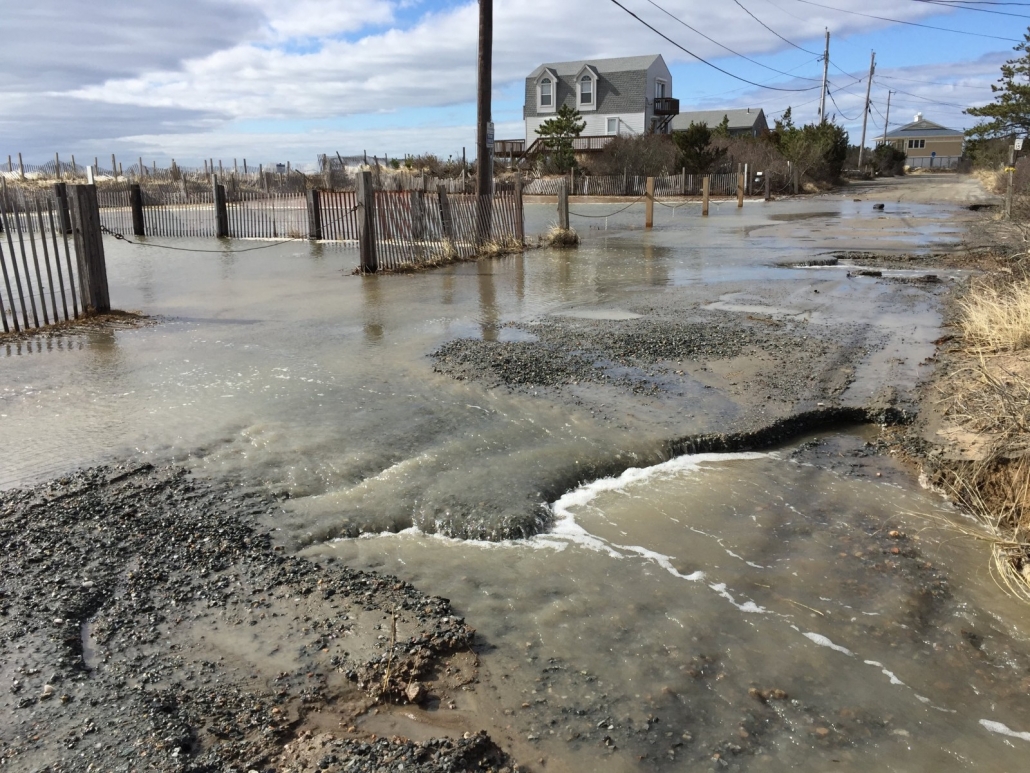
Storm surge overwash in Charlestown barrier-strip island due to nor’easter storm in March 2018. Photo © Jeeban Panthi
By Hannah Richter, Circle of Blue – August 2, 2022
- Saltwater is creeping inland from Maine to Georgia, with southeastern states experiencing intrusion the fastest. Climate change amplifies the rate of intrusion.
- Adaptation is costly. Treatment plants, water pipelines, and storage facilities can cost cities millions of dollars.
- Prevention is important, too. Irrigating lawns and golf courses can use as much as 60 percent of freshwater resources in coastal towns.
From its wide sandy beaches to the green fairways of its 21 golf courses, Hilton Head Island appears as it has for the past 66 years: a summer paradise. But lurking underneath, the waters of the salty Atlantic have overtaken six of the island’s 12 original drinking water wells, forcing the local water utilities to abandon them.
Saltwater is poised to intrude and render five more wells unusable by 2024, said the Hilton Head Public Service District.
At a rate of 400 feet per year, saltwater is migrating west from the ocean to once-secure inland groundwater reserves. Hilton Head is fast becoming a prominent test case of rising sea levels and intense coastal storms heralded by climate change.
Saltwater intrusion refers to the landward movement of seawater into freshwater systems. It’s a game of density: saltwater is denser than freshwater, so it remains underneath the freshwater in water tables. When the freshwater volume decreases, saltwater begins to take its place. Mixing then occurs, contaminating the whole supply. At high concentrations of salt in drinking water, people can develop hypertension, which exacerbates pre-existing health conditions and puts the elderly at higher risk of stroke.
The telltale signs of an impending drinking water problem are a slight salty taste and some cloudiness. At low concentrations, say health authorities, salty water is more a nuisance than a health threat. But higher salt concentrations, the likes of which are appearing in increasing numbers of Atlantic Coast wells, render water unsuitable for drinking or farming.
After years of anticipation, states are finally mobilizing. Teams of researchers are conducting well monitoring studies from Maine to Georgia. Southeastern states are seeing saltwater intrusion the fastest, with the Maryland Geological Survey estimating an increase of 15 percent in state salinity by 2025.
The process can be thought of like a seesaw, explained Holly Michael, director of the Delaware Environmental Institute. “It’s a balance between the land and the sea. So if you have enough freshwater on land, then it balances out sea level. But if you take away some of that freshwater by pumping it out, then that upsets the balance and the saltwater starts to move inland.”
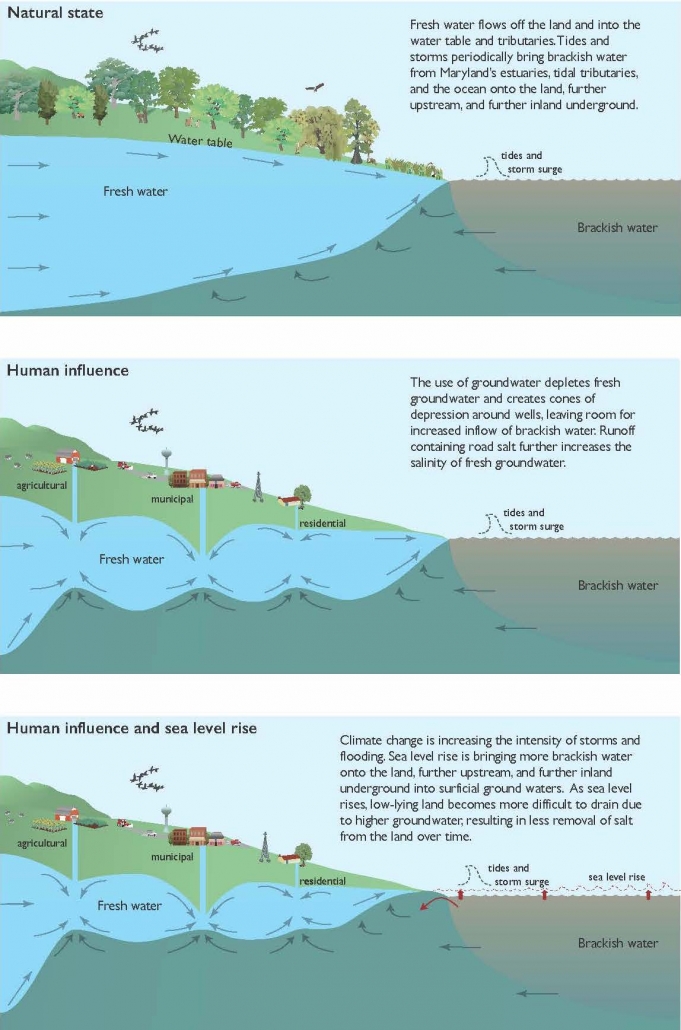
Source: Maryland Department of Planning
Pumping water for coastal households, industries, and agriculture exacerbates the effects of a factor that’s been tipping the seesaw for decades: sea level rise. A result of global warming, sea levels are rising particularly quickly on the East Coast, with states like North Carolina experiencing sea level rise between three and ten times faster than the global mean.
During a storm surge, which is a discrete rise in seawater levels caused by weather events like hurricanes, large amounts of salt get deposited on top of coastal lands, in turn seeping into the groundwater. Sea level rise is sneakier, entering groundwater systems from beneath the surface. When salt infiltrates a water source, many factors determine how long the source will remain contaminated.
During “pulse events” like storm surges, the acute influx of salt can be washed out over a few months or years by natural water cycling. For “press events” like sea level rise, however, the continuous nature of the salt exposure makes it difficult to flush out. Climate change is already increasing both pulse and press events.
“I call [sea level rise] a kind of slow poison,” said Jeeban Panthi, a PhD candidate in geosciences at the University of Rhode Island. In contrast to storm surges, “sea level rise is a continuous invasion of saltwater,” Panthi said.
“Even though we maybe think that groundwater is somehow isolated from the ocean, it’s not,” added Dr. Allison Lassiter, assistant professor at the University of Pennsylvania focusing on urban water management. Groundwater is “connected in the same way that surface water is,” and is therefore subject to the same challenges that come with supplying coastal inhabitants.
The Environmental Protection Agency has set an upper advisory level for salt in drinking water at 30-60 parts per million. At 250 ppm, salt can begin to affect taste and cause cloudiness. Most people don’t notice the saltiness until 400 ppm. In Florida, some aquifers have reached 1000 ppm.
Having faced saltwater intrusion earlier than their neighbors, the three Hilton Head Public Service Departments are taking action to maintain their water supply. The island has spent over $129 million since 1998 to construct a pipeline for treated mainland surface water and to build and operate a Reverse Osmosis Water Treatment Facility and an Aquifer Storage and Recovery Facility. Hilton Head forsees spending another $80 million in the next two decades, said Pete Nardi, General Manager of the Hilton Head Public Service District.
Despite the risks, governments and researchers seem far more concerned than citizens. Dr. Soni Pradhanang, associate professor of hydrology and water quality at the University of Rhode Island, explained, “Saltwater we don’t consider as a contaminant. Salt water is still drinkable, that’s how people see it.”
Added Panthi, her graduate student, “People have not taken saltwater intrusion very seriously. Water is salty? Just use it for boiling pasta.”
“At the time being, most of [the wells] are not at immediate risk, but they’re going to have to pay attention,” Manager for Research Conservation and Management with the Maryland Department of Planning Jason Dubow noted.
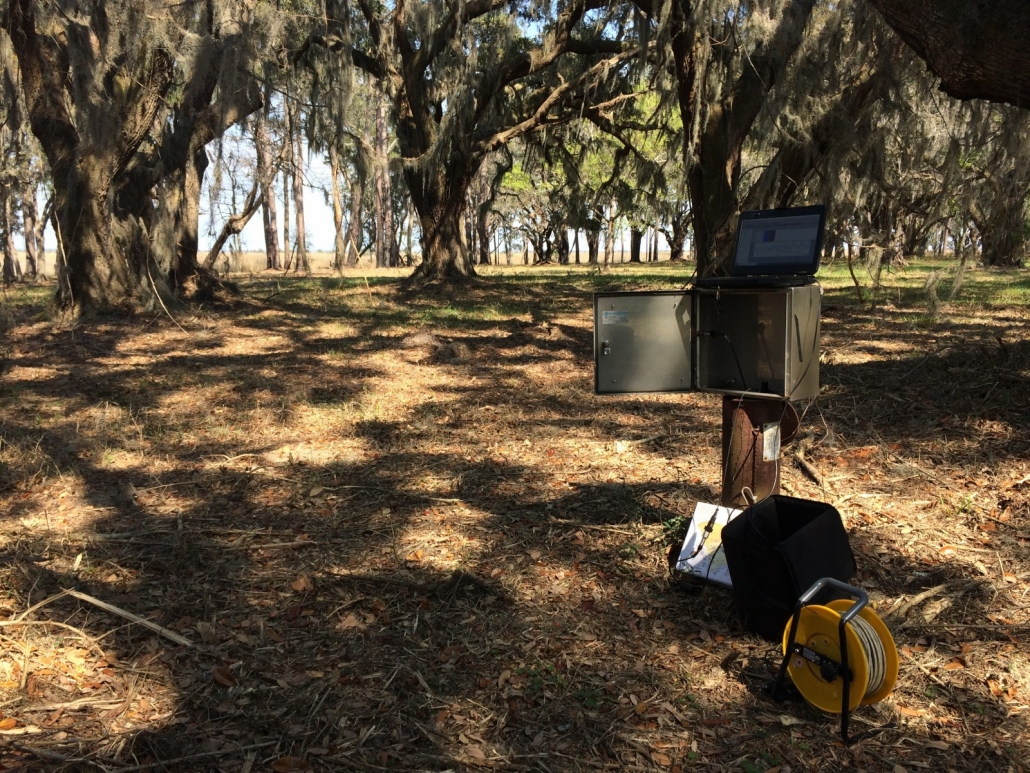
A saltwater intrusion monitoring well at Santee Coastal Reserve McClellanville. Water levels are shown on the screen. Photo © Brooke Czwartacki
While salt may be an emerging contaminant on the East Coast, it’s far from a new threat to Florida, which has been battling salty drinking water since the early 1900s. This is largely due to Florida’s geology, where the porous limestone base allows saltwater to seep in from underneath cities like Miami.
Differing hydraulic and geologic conditions across states mean that saltwater will infiltrate groundwater on varying timescales along the East Coast. Differing water withdrawal patterns in each state are also crucial factors in how long it takes to see salinization. For example, Georgia has a suite of coastal farms, whereas Rhode Island has a host of seaside tourist destinations. Additionally, at the state level, different coastal communities rely on different water sources which may not salinize at the same time.
Still, two similarities rise above state differences: low income communities and coastal tourist towns raise the most concern.
“Oftentimes, [low income communities] are located in areas that are flood prone to begin with,” said Andy Lazur, a water quality specialist at the Central Maryland Research and Education Center, who works primarily with homeowners. “We have not only the challenge of increasing sea level rise, but also what can they do about it? And can they afford it?”
Many low income communities on the East Coast are located in rural areas, increasing the likelihood that a household’s water comes from its own independent well, said Brooke Czwartacki, a hydrologist in the South Carolina Department of Natural Resources. Rural and low income communities have low population densities, so they don’t have the infrastructure to pull water from a common source like more populous (and better funded) towns or cities do. Instead, finding clean drinking water “falls on the burden of the individual homeowner to retrofit their systems.”
With saltwater contamination, retrofitting one’s household usually consists of installing a reverse osmosis system. A whole-house reverse osmosis system can cost $20,000, with even a small under-the-sink system totaling $250 to $1,500, Lazur said. If not a retrofitting, people turn to bottled water for drinking, racking up expenses and plastic pollution over time
“Consider somebody that’s on retirement income or is low income,” Lazur said. “That’s cost prohibitive.”
Ironically, the other group scientists worry about includes some of the East Coast’s wealthiest residents: homeowners in coastal tourism communities. Block Island, RI, Ocean City, MD, and Hilton Head are all at risk due to their bustling summer tourism. As people flock to the coast for vacation, water pumping increases dramatically for drinking and irrigating lawns and golf courses. Combined with high evaporation in the summer, the freshwater side of the seesaw dips, allowing saltwater to move further inland.
Coastal towns are better equipped with money and resources to combat threats like saltwater intrusion, but even Ocean City balked at the $25 million needed to build a desalination plant, Dubow said.
Desalination, certainly the most common method to address saltwater contamination, has more concerns than just price. “It requires a lot of energy inputs,” said Lassiter. “It can be very land intensive. And it doesn’t produce the volumes of water that a lot of people want it to produce.”
So what’s better?
“In general, the idea of building up a portfolio of water supplies is essential,” Lassiter said. A water portfolio includes all sources and uses of water for a municipality, with the goal to diversify that portfolio. If thousands of residents rely on a single aquifer and that aquifer gets contaminated, there need to be alternative sources of water to tap into. According to Lassiter, “building more redundancy into systems is a great way to do that.”
There are also emerging technologies to deal with saltwater intrusion, like injecting treated freshwater into an aquifer for future use, integrating non-potable water for non-drinking into city planning, and prioritizing green infrastructure like marshlands to suck up some of the salt from pulse events.
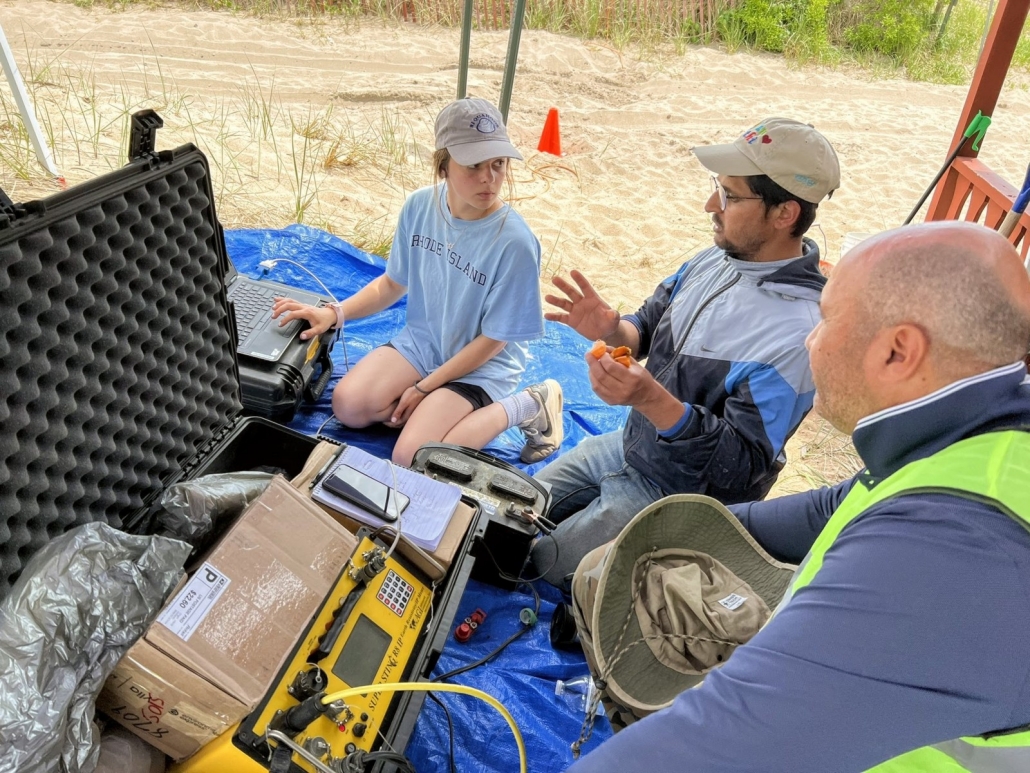
Saltwater mapping with electrical resistivity imaging in the southern coast of Rhode Island by a team of University of Rhode Island students. Photo © Soni M. Pradhanang
But truly preventing saltwater intrusion might need to start earlier in the process: at preventing freshwater extraction.
Nowhere does that ring truer than in Hilton Head. Between 40 percent and 60 percent of water demand is for residential irrigation like lawns and gardens. Pete Nardi of the Hilton Head Public Service District said that education is a crucial part of Hilton Head’s adaptation strategy. They tell Hilton Head residents to check their sprinkler systems, install rain sensors, and opt for native plants that require less water.
Adaptation to saltwater intrusion is more a mindset than a quick fix. According to Nardi, the thought process is simple: “We’re losing this source of water, we still have the demand for water, what are we gonna do?”
Part one of a multi-part series on East Coast saltwater intrusion. Read the series here.
Hannah Richter is an editorial intern for Circle of Blue covering saltwater intrusion on the East Coast and designing graphics. She is a rising senior at the University of Chicago studying Environmental Science and Creative Writing in Nonfiction. In her free time, she directs her university’s ballet company, cooks vegan food, and thrift shops.

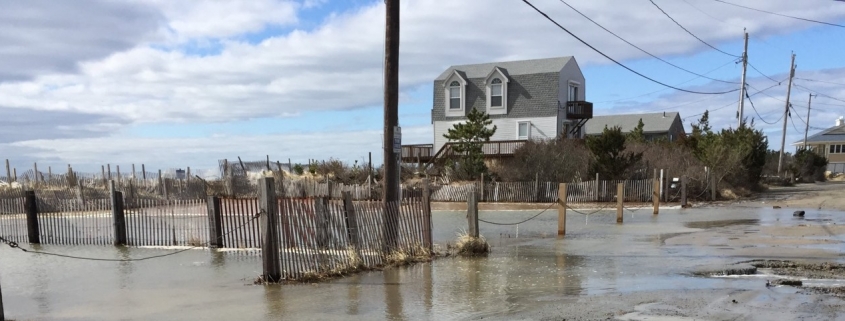

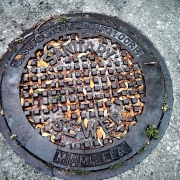
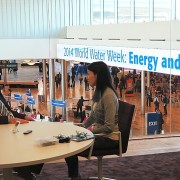
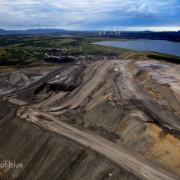
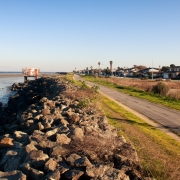





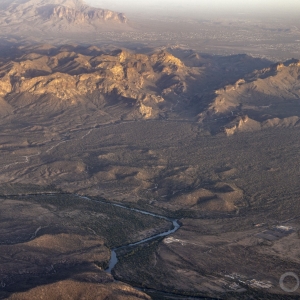 © J. Carl Ganter / Circle of Blue
© J. Carl Ganter / Circle of Blue
This article gives good descriptions of the effects of saltwater intrusion into freshwater aquifers, but fails to fully and correctly identify the cause(s) of saltwater intrusion by mentioning climate change and sea level rise a dozen times, but reporting only one mild (and accurate) reference to over-pumping. Some of the apparent sea level rise on the east coast of the United States is due to continued drifting apart of the North American and European Continents, just as the apparent sea level drop on the west coast is due to continued subduction of the Pacific Plate under the North American Continent. Some localized subsidence of the land surface can occur in areas where an aquifer is being over-pumped. Even in mid-continent areas whose aquifers are not connected to the ocean, saltwater intrusion occurs as the piezometric surface of the aquifer water is reduced by pumping at a faster rate than the aquifer can recharge itself naturally. Gravity stratification of the denser, more mineralized water has occurred over the eons. Over-pumping creates the mentioned “cones of depression”, which allows the saltier water to rise from the lower part of the aquifer up into the pumped interval of sand. Sadly, the salted-out wells will probably never be usable again, as the flow paths for the saltwater through the rock have been established and cannot be plugged off by natural recharge of the aquifer while the salted-out well is idle.
This is also happening in Louisiana on our coast. We are constantly losing our freshwater due to various influence both anthropogenic and natural.
Who are, where are the visionaries (thinkers, leaders, entreprenours, problems solvers) who are doing something about humankind’s life and death struggle with fresh, drinkable water issues.
The problem and scope of same seems to be well documented. The issue is who, what entity, is developing answers and implementing solutions to this and the infinite equally pressing related water problems.
Maybe the US could lead the world by example and undertake an infrastructure plan that connects water rich areas with our rivers, lakes, dams, aquafers, desalination plants, reservours, using the no longer relevant carbon delivery piping system…to deliver water where needed like the interstate highway system marvel of the past.